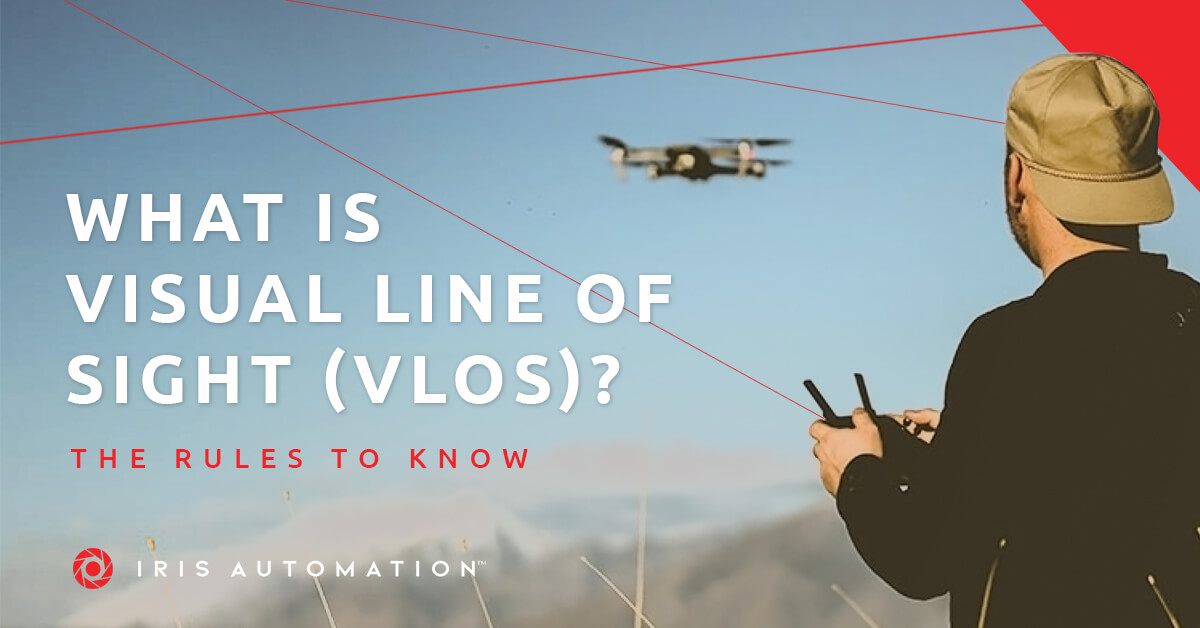What is Visual Line of Sight (VLOS)?
Visual Line of Sight Rules (VLOS) apply to small unmanned aircraft in the same way that Visual Flight Rules (VFR) apply to manned aircraft: VFR are a set of regulations governing piloting an aircraft during weather conditions that allow for visibility. According to the FAA, VFR flight is based on the principle of “see and avoid.”
In manned aviation, this principle is generally fulfilled by having a pilot on-board looking out from inside the aircraft and scanning the horizon for any aircraft that may be on a collision course with their aircraft. In unmanned aviation, however, it is not possible for the pilot to “see” other aircraft heading towards their drone. This is why the current FAA rules dictate that a drone or small UAS operation is conducted “within visual line of sight.”
An operator of a small UAS must always be capable of maintaining visual line of sight of the small unmanned aircraft they are piloting, unaided by any technology other than prescription glasses or contact lenses (note that this excludes sight-enhancing technologies such as binoculars or infrared goggles). This is called Visual Line of Sight operations (VLOS).
Part 107 of FAA regulations cover rules for UAS operations for drones weighing less than 55 pounds.
Text of Part 107.31:
§ 107.31 Visual line of sight aircraft operation.
(a) With vision that is unaided by any device other than corrective lenses, the remote pilot in command, the visual observer (if one is used), and the person manipulating the flight control of the small unmanned aircraft system must be able to see the unmanned aircraft throughout the entire flight in order to:
(1) Know the unmanned aircraft’s location;
(2) Determine the unmanned aircraft’s attitude, altitude, and direction of flight;
(3) Observe the airspace for other air traffic or hazards; and
(4) Determine that the unmanned aircraft does not endanger the life or property of another.
(b) Throughout the entire flight of the small unmanned aircraft, the ability described in paragraph (a) of this section must be exercised by either:
(1) The remote pilot in command and the person manipulating the flight controls of the small unmanned aircraft system; or
(2) A visual observer.
Additional information from an FAA Fact Sheet:
“You can fly during daylight (30 minutes before official sunrise to 30 minutes after official sunset, local time) or in twilight with appropriate anti-collision lighting. Minimum weather visibility is three miles from your control station.
You currently cannot fly a small UAS over anyone not directly participating in the operation, not under a covered structure, or not inside a covered stationary vehicle. No operations from a moving vehicle are allowed unless you are flying over a sparsely populated area.”

What is a Visual Observer?
If a drone pilot is unable to maintain visual line-of-sight with the drone during an operation, for example while using First Person View, a Visual Observer (VO) is required.
The VO and remote pilot in command must maintain communication at all times to ensure that the VO is able to see the drone’s position and scan its surroundings to identify any potential airspace collision hazards. Note that “daisy chaining,” or multiple, successive visual observers to extend the flight distance of the UAS, is not normally approved.
The basic duties of a visual observer are outlined in Part 107 Section 107.33.
Text of Part 107.33:
§ 107.33 Visual observer.
If a visual observer is used during the aircraft operation, all of the following requirements must be met:
(a) The remote pilot in command, the person manipulating the flight controls of the small unmanned aircraft system, and the visual observer must maintain effective communication with each other at all times.
(b) The remote pilot in command must ensure that the visual observer is able to see the unmanned aircraft in the manner specified in § 107.31.
(c) The remote pilot in command, the person manipulating the flight controls of the small unmanned aircraft system, and the visual observer must coordinate to do the following:
(1) Scan the airspace where the small unmanned aircraft is operating for any potential collision hazard; and
(2) Maintain awareness of the position of the small unmanned aircraft through direct visual observation.
Get started on your BVLOS approval
Article sources:
https://www.faa.gov/uas/media/Part_107_Summary.pdf
https://www.law.cornell.edu/cfr/text/14/107.31
https://www.law.cornell.edu/cfr/text/14/107.35
https://www.faasafety.gov/files/gslac/courses/content/25/185/vfr%20weather%20minimums.pdf
https://www.faa.gov/news/fact_sheets/news_story.cfm?newsId=22615

